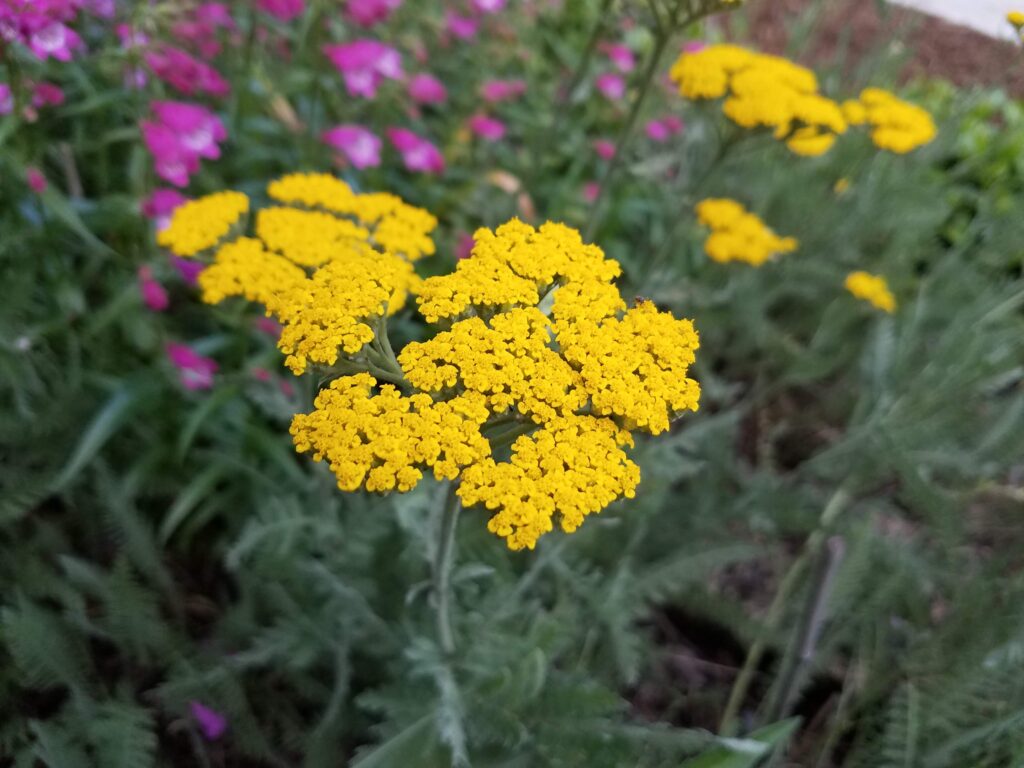One of the first flowers I can remember in my mom’s garden was yarrow. The sweet, musty smell of them always takes me right back to the little garden she had outside the kitchen door. Consequently, it was also one of the first things I planted when I started my own garden after moving in with Christian. Back in those days, I was less picky about planting natives and avoiding invasives, but I’d still choose to put yarrow somewhere, even if I were doing it all over again today, because I love it that much.
Achillea millefolium
Yarrow is a perennial native to Europe and Asia that has naturalized itself in North America. If you’re not careful, it can take over your garden. (Fortunately, I have a non-reseeding variety, which I like to think has limited its aggressiveness.) Nevertheless, the plant has a rich history of being used in medicine throughout the centuries and across the globe. It has antiseptic, antimicrobial, and antibacterial properties; it can be used to reduce pain and stop bleeding. It is even said that Achilles had his soldiers make use of it after battle, hence its genus Achillea. Historically, it has been used to aid breathing, lower fevers, and treat indigestion, urinary tract infections, parasites, and menstrual cramps.[1]
If you would like a little more of a scientific basis to back up these claims of health benefits, you can look no further than one of the compounds found in the yarrow plant: salicylic acid. If the name sounds familiar, that is because it is used in acne medication and in the making of aspirin.[2] Yarrow has been used in brewing tea and ale, often with an eye toward medicinal use, though the flavor is quite good as well (in my opinion). Three years ago today I brewed some yarrow ale with my local brewers guild. I then shared it as part of a class I taught on medieval ales, specifically exploring what herbs were used as bittering agents before hops (and men) took over the brewing industry in the late middle ages.[3]

IT IS IMPORTANT TO NOTE before we go any further: there were many ingredients used in the middle ages for medicinal purposes that we modernly know to be toxic. When I taught this class, I put big disclaimers on my course materials and let people know that they should use their own judgment before sampling anything because all four of the herbs used for this class (heather, creeping Charlie, yarrow, and wormwood) contained at least one chemical substance associated with physiological impacts. The last possible thing I wanted was to be responsible for an adverse health reaction in someone who had a chemical sensitivity or underlying medical condition.
The compound of concern in yarrow is thujone, which is best known for its presence in absinthe. It has stimulant and psychoactive qualities, creating mood elevating effects in low doses but muscle spasms and convulsions in high doses. In high enough concentration, it can be toxic to brain, kidney, and liver cells. There is at least one documented case of renal failure after a man drank straight wormwood essential oil, thinking it was absinthe.[4] Foods and beverages in the United States must be “thujone-free,” containing less than 10mg of thujone per liter. EU regulations allow 35mg per kg, so probably closer to 44mg per liter. Thujone can be found in juniper, mugwort, oregano, sage, yarrow (trace amounts), and wormwood.[5] Additionally, though not mentioned on the Wikipedia page, other sources list it as an abortifacient.[6]
I tried to determine whether the ales I was sharing were “safe,” but it is hard to make that claim without conducting a laboratory analysis, especially since there is so much variation in the plants themselves.[7] One source says that 4.5g of yarrow per day is a traditional quantity for treating various conditions, but there are no clinical studies to validate that dose.[8] One study proposed that, based on exposure concentration and reaction levels in rats, humans would not be able to reach levels of concern through thujone-containing foods and beverages, citing 2-20 cups of wormwood tea as the limit for an Acceptable Daily Intake, and stating that “the short-term medicinal use of these herbs can also be regarded as safe.”[9]
All that being said, I am not making any claims on safety levels should you try this at home. Be cautious, especially if you are pregnant.

Research Through Experimentation
But here’s where it gets interesting. The herbed ales class was taking place at the Pennsic War, an annual medieval reenactment event that (pre-pandemic) lasted for two weeks and hosted upwards of 10,000 people from around the globe.[10] There are myriad activities to take part in during the event, and one of them is a half marathon, which circles the site three(ish) times. Around the same time I was brewing the ales for my class, I was asked to provide some beverages for a biergarten that would be held at the race finish line.
In the middle ages, a common brewing technique was to reuse grain for brewing additional batches. During the first “running,” you could extract enough sugar from the grain to achieve a fairly high alcohol level, but you wouldn’t get all of it. By using it again, the second “running” could result in a low ABV beverage, or “small” ale/beer [11] – something for servants and children to drink. Having no time to get more grain for a separate batch, and having always wanted to try the process, the perfect opportunity presented itself. And furthermore, using yarrow – an anti-inflammatory and analgesic – in this batch seemed like the perfect gimmick for a post-race beverage.
The grain bill was a very basic 17 lbs of pale ale malt so the herbs could take center stage in the tasting. The first running (for the herbed ales class) resulted in a 12.5% ABV ale with a very strong flavor. The second running (for the biergarten) resulted in a 3.5% ABV ale with an incredibly light flavor, but that’s really a good thing for post-race drinking. In the batch from the second running, I used 6oz of fresh yarrow flowers from my garden (3oz in the boil, and 3oz for infusion during primary fermentation). With a yield of 18 1-liter bottles, that comes out to a little over 9g of yarrow per liter… or a little over 5g of yarrow per pint of ale. Based on the “dosage” I quoted above, I was fairly certain I wasn’t going to send anybody into seizures, especially since the weight of dried herbs can be as little as 1/3 the weight of fresh, and I would bet a small amount (not anyone’s life) that the 4.5g number refers to dried yarrow.

If you know me (or read this blog regularly enough to know about my unhealthy habits) you know that while I love running marathons, I am absolutely terrible about training for them. I was busy enough with Pennsic prep that summer (brewing and bottling beers and meads, assembling materials for multiple classes I was teaching, doing calligraphy and illumination for award scrolls, practicing for two separate choir concerts, and trying to organize a triple-booked schedule for my week of “vacation”) that I did absolutely nothing to prepare for the 13-mile run. I have run enough half marathons with zero training to know that you should not do that. But I have also run enough half marathons with zero training to know I can get away with it if I accept the fact that I will be in pain for several days afterwards, hobbling around with stiff muscles.
After I finished the half marathon, I hung out in the biergarten, serving drinks (and drinking). My yarrow ale was an absolute hit because it was so light and refreshing. As runners and spectators tried it, I told them about the medicinal benefits of yarrow, and how it was used in the middle ages to treat a variety of ailments. I stood there drinking it too as I cheered runners across the finish line, but didn’t think much about it other than the fact that it tasted so good on a hot day after a long run. I really didn’t give the yarrow another thought until the next morning when I got out of bed and barely felt any soreness anywhere in my body. I couldn’t believe it actually had such a significant effect – and from my own experience with bad training, I know I should have been barely mobile.
In any case, now that my yarrow is blooming again, I want to make sure I harvest some and use it this year – either in tea when I need some monthly pain relief or in another batch of “Yarrow Lite: Ye Originale Lite Bier,” as I called it in my brewing journal. Pennsic is finally happening again this August, and so is the half marathon. I haven’t run a race since my plantar fibroma diagnosis,[12] so my participation remains to be seen, but I know there will be a biergarten in need of beverages.
Have you used yarrow in any beverages or home remedies? I’d love to hear your experiences below.
Thanks for reading!
[1] https://www.goodreads.com/en/book/show/157268.Sacred_and_Herbal_Healing_Beers
[2] https://en.wikipedia.org/wiki/Salicylic_acid
[3] https://radicalmoderate.online/equity-in-brewing-part-1/
[5] https://en.wikipedia.org/wiki/Thujone
[6] https://www.drugs.com/npp/yarrow.html
[7] https://www.cocktailsafe.org/wormwood-and-thujone.html
[8] https://www.drugs.com/npp/yarrow.html
[9] https://pubmed.ncbi.nlm.nih.gov/20727933/
[10] http://www.pennsicwar.org/
[11] https://en.wikipedia.org/wiki/Small_beer
0 Comments